THE NO. 8 MACHINE OF FULTON STREET (1876)
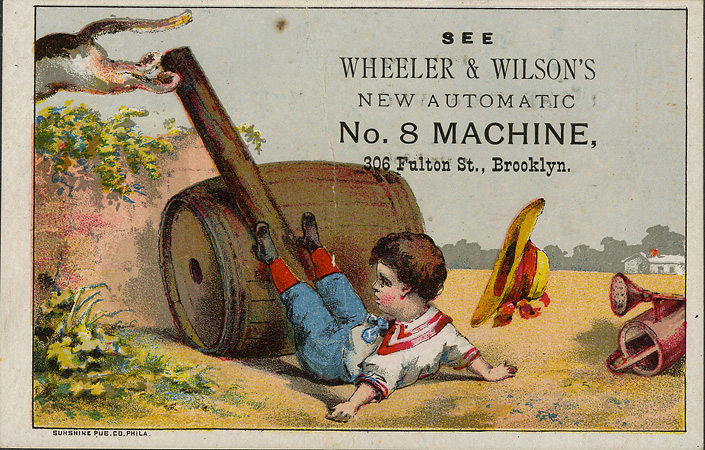
The No. 8 Machine.
Such a romantic honorific. The name literally rolled off the tongue and dazzled the listener with the rhythm of its mellifluousness and style…
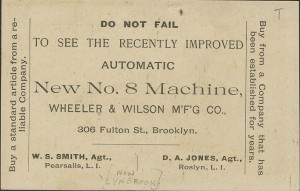
And it smells just as bad.
Buyers of sewing machine back in the late 1800s, though, were really not shopping for a sexy name. They were looking for dependability and speed.
Stylish sewing machines, then, were like the hotrods of the day for garment producers. Just as for the marketers of the 20th century’s Mark VI or Chrysler 300, or even the Mercedes 190-E, present-day automobile manufacturers always knew that that they “had” their buyers with their brand. They didn’t need a sexy name for their cars. They simply had to tack on the latest model number to their speed machines to let their faithful customers know that it was a new year and that they were once again out of style and out of step with the times.
One of the producers of the 19th century speedster sewing machines was the Wheeler & Wilson Company.
Their hotrod was the No. 8.
SELLING THE NO. 8
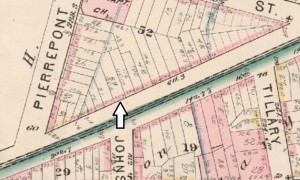
Wheeler and Wilson sold their No. 8 Machine from about 1872 and running at least through the mid-1880s.
Located at 306 Fulton Street in their 4-story roughly 25′ X 100′ iron front Brooklyn warehouse located Wheeler & Wilson’s No. 8 Machine manual sewing machine provided them with the bulk of their .
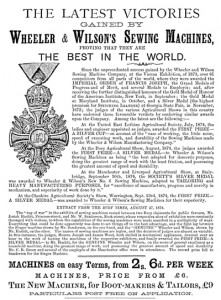 Their sewing machines were superb pieces of sewing engineering. They were so good, in fact, that they won numerous medals at various exhibitions and fairs throughout the world.
Their sewing machines were superb pieces of sewing engineering. They were so good, in fact, that they won numerous medals at various exhibitions and fairs throughout the world.
Just within the short period of 1873-1874, the list was long.
At the Vienna Exhibition of 1873, out of more than 81 competitors from all over the world, Wheeler & Wilson were awarded the Imperial Order of Francis Joseph. They received the Grand Medals of Progress and of Merit, the Gold Medal of Honour of the American Institute, New York, in September 1873, and the Gold Medal at the Maryland Institute in October. One jury even awarded Wheeler & Wilson the First Prize – a silver cup – on account of the No. 8’s “ease of working, the little noise, speed of executing work, and durability of the sewing machines made by the Wheeler & Wilson Manufacturing Company.”
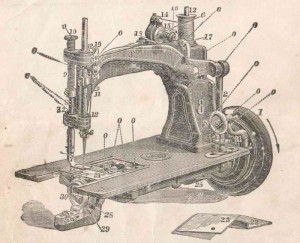
Unfortunately, though, their star machine would not be enough to save the company from its cheaper competitors. At the time, cheap imitators were flooding the market and challenging the dominance of Wheeler & Wilson. Over the next 20 year period, Wheeler & Wilson started descending on a “downturn.”
By 1905 Singer had bought them out and Wheeler & Wilson were no more.
Their machines, though, well-made and durable, continued to be used many years later.
———————————————————————————————————————–
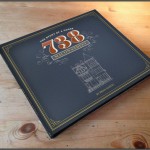 The story you just read was composed from historical research performed by The Brownstone Detectives. Allow us to do an in-depth investigation of your house and its former owners and produce your very own House History Book. Your hardbound coffee table book will include an illustrated and colorful narrative timeline that will bring the history of your house to life. Contact us today.
The story you just read was composed from historical research performed by The Brownstone Detectives. Allow us to do an in-depth investigation of your house and its former owners and produce your very own House History Book. Your hardbound coffee table book will include an illustrated and colorful narrative timeline that will bring the history of your house to life. Contact us today.